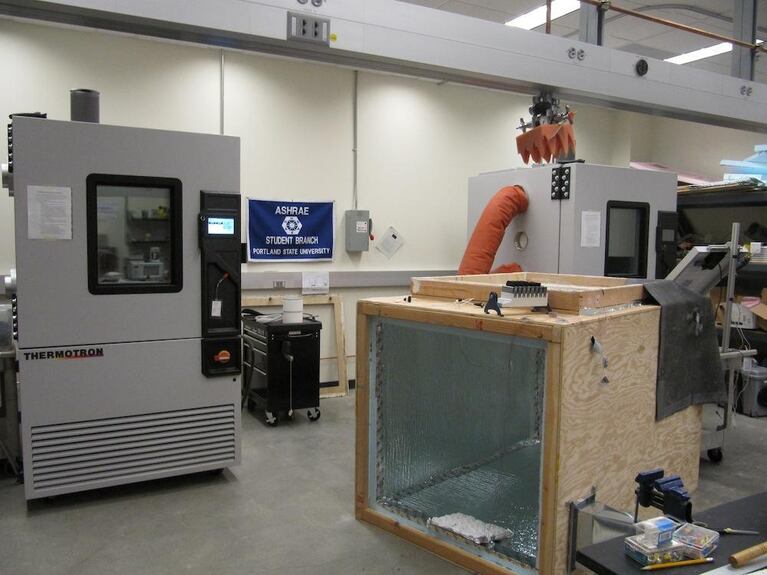
The Green Building Research Laboratory at Portland State University. Researchers and industry are partnering here to devise materials and methods for green building construction.
Rob Manning
PORTLAND -- As director of Portland State University's Green Building Research Lab, Dave Sailor receives lots of green building products. There's an untested tube of green roof material in front of him. It came with a familiar request.
"If you ever get a chance to test this, please do so. It's still sitting on the table, right now," Sailor says with a laugh.
Sailor says he can’t test all the materials that come his way. But his ears perked up when the owner of a duplex called recently. See, duplexes are perfect for experiments because engineers can test one half, and leave the other as a control. And this wasn't just any duplex. It was a "passive house" – meaning it's so well insulated, it requires very little energy. PSU is now using the duplex to test a kind of experimental insulation meant for passive homes.
"Everything from temperature sensors in the concrete foundation, to temperature sensors and humidity and CO2 sensors in the building space itself," Sailor says. "We're sub-metering every circuit in the building itself, so we can understand how the occupants are using energy."
Green Agenda in Portland
Leaders of Oregon's green business sector are converging in Portland Tuesday for a conference called "Go Green '11."
Some tests start with a simpler story. Kelly Rauer is with the Portland company, Indow Windows (link: Indow Windows). She says frustration led to her boss's latest invention.
"He was like many Portland homeowners. He has a 1920's bungalow with old leaded glass and divided-light windows, which he loved very much. But they were extremely drafty," she says.
To combat the draft, he came up with a plastic storm window with a pressurized tube around the edge. It's meant to squeeze into an inside windowsill and block any whisper of a draft.
The Indow Window launched last year. Along the way, the company got help from the green product experts at Portland State University. Green Building Research Lab (link: PSU's green building lab) director Sailor says the company was looking to save homeowners the costly effort of ripping out and replacing classic windows.
"You can accomplish much of the same benefit at a much lower cost with their product. At least that was their claim initially," he says. "But they didn't have the data to back up that claim. So that's where we came in."
Before doing tests in homes or businesses, PSU often puts products in two refrigerator-sized chambers and bombards them with heat, cold, and humidity. Between the chambers is another big box with an insulated blower attached. It was built for the Indow Window.
Sailor says his lab's job isn't to promote products. In fact, one of things he likes about running the lab is that he finds problems companies missed.
"People will typically focus in on a technology that has a great deal of promise for solving one problem," he says. "But they don't ask questions that would help them identify whether it might actually contribute to a different set of problems."
Sailor says the lab regularly finds companies need to modify their expectations for products.
“That's why I think the connection between industry and the universities is a little bit of a sensitive one, but at the same is a very important one," he says.
Sailor says the Indow Window managed to block out cold air – and intrusive sounds – in the laboratory. Now, the Green Building lab is helping test the window inserts in homes, to see how they respond to high winds, and other conditions the lab can't replicate.
Indow Windows is now running a pilot in Portland households, with the help of PSU's Green Building Lab. But they're selling the window inserts, too.
Certainly, Northwest companies don't have to go through Portland State to get a product to consumers. And PSU's engineers can't help with what's often the last hurdle for companies: convincing people to incorporate new products in their homes. Alexis Allan is with the Northwest Energy Efficiency Alliance. Her group wants to get ductless heat pumps – or DHPs – to play a bigger role in home heating and cooling.
"You would find them in like a server room, or you might use them in a mother-in-law unit," Allan says. "We were really targeting what we call this 'displacement approach' where we were advocating for people to put a DHP in the main living area of your home."
Allan says the pumps are in 12,000 Northwest homes, but her group wants them in 150,000 homes.
Back at the PSU Green Building Research Lab, Dave Sailor says a lot of the lab’s work goes beyond helping individual companies. His goal is to advance the whole field of energy research.
(This was first reported for Oregon Public Broadcasting.)



